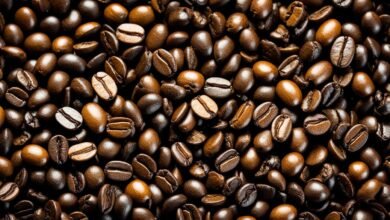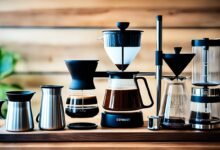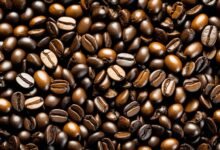Top Tips for Using Your Espresso Machine Like a Pro

As a self-proclaimed coffee enthusiast, I’ve spent countless hours perfecting the art of brewing exceptional espresso at home. From experimenting with different grinders to fine-tuning my tamping techniques, the journey has been both challenging and deeply rewarding. If you’re like me, passionate about unlocking the secrets of barista-level espresso, then this comprehensive guide is for you.
Key Takeaways
- Mastering the art of espresso brewing requires a combination of the right equipment, quality ingredients, and precision techniques.
- Investing in a good quality espresso grinder and understanding how to properly dose and tamp the coffee is crucial for consistent results.
- Maintaining your espresso machine through regular cleaning and descaling is essential for extending its lifespan and ensuring the best-tasting shots.
- Experimenting with different brew ratios, milk frothing techniques, and temperature surfing can help you fine-tune your espresso game.
- Staying informed about the latest espresso brewing trends and practices can inspire you to take your home barista skills to new heights.
Essential Espresso Machine Tips for Beginners
For new home baristas, mastering the art of espresso brewing can seem daunting at first. However, by starting with a reputable learning resource and using fresh, properly stored coffee beans, you can set yourself up for success. Seeking out a comprehensive home barista class or a well-curated online tutorial can provide a solid foundation in the fundamentals of espresso brewing, including proper dosing, distribution, tamping, and brew ratio techniques.
Start with a Reputable Learning Resource
Trying to piece together information from various online sources can lead to confusion and frustration. Instead, find a learning resource that offers a structured curriculum, guiding you step-by-step through the essential espresso brewing skills. This will ensure you develop a solid understanding of the Espresso Brewing Fundamentals before attempting to brew your own drinks.
Use Fresh, Properly Stored Coffee Beans
Using fresh, properly stored coffee beans is crucial for achieving great espresso. Beans that are 4-14 days off-roast will provide the best flavor, so avoid using coffee that is 30-60 days old or older. Proper Storing Coffee Beans for Espresso can help maintain their freshness and prevent staling, which can negatively impact the taste of your drinks.
By starting with a reputable learning resource and using fresh, high-quality coffee beans, you’ll be well on your way to becoming a confident Home Barista and mastering the art of Espresso Machine Tips for Beginners.
Mastering Dosing and Weighing
Achieving consistent, high-quality espresso shots starts with meticulous espresso dosing techniques. One of the most common issues faced by new home baristas is inconsistent dosing and output. Using an accurate digital scale to measure your coffee dose, rather than eyeballing it, is essential for dialing in your espresso recipe.
Invest in a Precise Coffee Scale
A scale with 0.1-gram precision will provide the feedback you need to make adjustments and achieve the desired brew ratio. Espresso baskets typically range in size between 15g and 25g, and baristas often use between 18 and 21 grams of ground coffee for a single espresso, measured to a tenth of a gram. Investing in a quality coffee scale is a simple upgrade that can significantly improve your espresso quality and consistency.
| Metric | Typical Range |
|---|---|
| Espresso Basket Size | 15g – 25g |
| Espresso Dose | 18g – 21g |
| Espresso Brew Ratio | 1:2 (Coffee:Water) |
| Espresso Brew Time | 25s – 30s |
By investing in a precise coffee scale, home baristas can take control of their Espresso Dosing Techniques and Weighing Coffee for Espresso, leading to more consistent and flavorful Precision Coffee Scales for Home Baristas.
Consistent Tamping Techniques
Achieving consistently level and evenly tamped espresso pucks is crucial for even extraction. New baristas often struggle with inconsistent tamping pressure, leading to uneven flow and suboptimal flavor. Using a calibrated, weighted tamper can help ensure you apply the same tamping force each time.
Mastering the technique of leveling the coffee before tamping will further contribute to a well-distributed puck and improved overall extraction. The Stockfleth method of coffee distribution was historically used, but the “tap technique” is now preferred for its effectiveness.
A study by Barista Hustle found only a 3% difference in shots pulled with various tamping forces ranging from 40lbs to 5lbs, indicating that consistent tamping pressure is more crucial than the exact amount of force applied for even extraction. Tools like the Saint Anthony Industries Levy tamper can ensure a level tamp every time.
The nominal doses for espresso range from 6 to 7 grams for a single shot and 12 to 14 grams for a double shot. Recent trends in cafes show a shift towards higher dose sizes, with single shots ranging from 8 to 10 grams and double shots from 16 to 20 grams. Approximately 20% to 25% additional dose can be achieved by slightly compacting the grinds in the basket prior to tamping.
Consistency in dosing is key, with some baristas preferring to use the same volume of grinds each time instead of weighing them for accuracy. Tamping is typically done with a pressure of around 30lbs in a straight down press, followed by a light twist to settle any stray grinds. In Italy, many cafes grind slightly finer and use a very light tamp of about 10 pounds.
Some baristas may opt for heavier tamps, while others use a nutating motion or a convexly curved tamper to distribute the pressure towards the edges of the basket. The use of a naked portafilter, a recent innovation, allows for direct observation of the extraction progress and can aid in improving leveling and tamping techniques.
“Consistent tamping pressure is more crucial than the exact amount of force applied for even extraction.”
The Importance of Water Quality
Maintaining the Espresso Water Quality is crucial for producing consistently great-tasting espresso at home. Hard water, high in minerals like calcium and magnesium, can lead to Avoiding Hard Water Damage and scale buildup that damages internal components of your espresso machine. This not only negatively impacts the extraction process but can also shorten the lifespan of your valuable equipment.
To protect your investment and ensure exceptional espresso, it’s essential to use water with the proper mineral content, ideally between 35-85 parts per million (ppm). Regularly testing your water and treating it with a filtration system or third-party water blend can help prevent Espresso Machine Descaling and extend the life of your espresso machine.
Avoid Hard Water and Scale Buildup
Hard water can wreak havoc on your espresso machine, leading to a buildup of scale that clogs internal components and disrupts the extraction process. This not only affects the taste of your espresso but can also cause long-term damage to your machine. To avoid these issues, it’s crucial to use water with the right mineral content and regularly maintain your equipment.
- Ideal water mineral content: 35-85 ppm
- Regular water testing and filtration or softening
- Periodic machine descaling to remove scale buildup
By prioritizing water quality and maintaining your espresso machine, you can enjoy consistently delicious espresso shots and protect your investment for years to come.

“Water quality is even more critical for espresso machines due to high pressure and fine grind.”
Proper Cleaning and Maintenance
Maintaining the cleanliness and optimal performance of your Espresso Machine is crucial for producing consistently great-tasting coffee. Regularly cleaning the machine’s components not only prevents mold and rancidity but also ensures the coffee you brew is safe and flavorful.
Experts recommend a combination of daily, weekly, and monthly cleaning routines to keep your espresso equipment in top condition. Professional baristas typically clean their machines daily, while home users can focus on more thorough cleaning once a week or at least once a month.
The backflush procedure, where you run a cleaning solution through the group head, should be done 5 to 10 times during a cleaning session. It’s also important to soak the portafilter meshes and the portafilter itself for 15–30 minutes to remove any old coffee residue.
To avoid issues like scale buildup, it’s essential to use filtered, soft water in your espresso machine. Descaling should be performed according to the manufacturer’s instructions, which may vary between models.
Regular maintenance, such as replacing small parts like valve rings and steam wands, can extend the lifespan of your espresso machine. With proper care, these machines can last 8–10 years or more.
Daily Cleaning Routine
- Wipe down the steam wand and purge it after each use
- Flush the group head before pulling each shot
- Replace cleaning cloths 2-3 times a day and launder them at high temperatures
End-of-Day Cleaning
- Backflush the machine
- Clean the steam wand and draining hose
- Clean the portafilters, filter baskets, and drip tray
By following a consistent cleaning and maintenance routine, you can ensure your espresso machine continues to produce top-notch coffee while preventing issues like mold and rancidity. Proper care is the key to a long-lasting, high-performing machine.
Frothing Milk for Espresso Drinks
Mastering the art of frothing milk for espresso-based drinks like cappuccinos and lattes is a crucial skill for any home barista. The right technique and understanding of milk types can make all the difference in achieving the perfect milk texture and microfoam that elevates these beloved beverages.
One of the keys to successful milk frothing is using the right type of milk. Non-fat or skim milk are often recommended for their ability to create a tighter, more stable foam due to their lower fat content. On the other hand, full-fat milk may result in a less airy, more dense foam, as the fat can weigh down the air bubbles.
Proper steaming technique is also crucial. Purging the steam wand for 5 seconds helps build the necessary pressure, while maintaining an ideal frothing temperature between 40-45°C. Texturing the milk until the thermometer reaches 60°C, aiming for a final temperature between 65-70°C, will yield the silky, microfoam-rich texture that’s perfect for latte art and a creamy mouthfeel.
| Milk Type | Frothing Quality | Recommended Use |
|---|---|---|
| Non-fat or Skim Milk | Excellent Foam | Cappuccinos, Lattes |
| Full-Fat Milk | Denser Foam | Specialty Drinks |
| Lactose-Free Milk | Poor Foam Quality | Not Recommended |
While dairy milk remains a popular choice, alternative milk options such as soy, almond, or oat milk can also be experimented with, each offering unique frothing properties and flavor profiles. Ultimately, the key is to find the milk that best suits your personal preferences and the specific drink you’re preparing.
“Properly prepared milk for specialty drinks will always be foamed for improved taste and texture.”
Learning to froth milk like a pro takes practice, but with the right techniques and an understanding of milk types, home baristas can elevate their espresso game and create cafe-quality cappuccinos and lattes in the comfort of their own kitchen.
Understanding Brew Ratios
The espresso brew ratio, the relationship between the weight of coffee used and the weight of the resulting espresso, is a crucial concept for home baristas to master. Having a defined recipe, such as using 20 grams of coffee to yield 30 grams of espresso, provides the necessary feedback to make adjustments and achieve consistent extraction.
Monitoring your Espresso Brew Ratios and making changes to the grind size or dose as needed will help you Adjusting Espresso Recipes and Calculating Brew Yield for optimal flavor. The traditional espresso brew ratio typically ranges from 1:2 to 1:2.5, while a ristretto shot features a ratio between 1:1 and 1:1.5, and a lungo shot has a ratio of about 1:3.
- Standard brew head in Flair products has a maximum output of 45ml.
- PRO 2 brew head in Flair products can yield a maximum output of 60ml.
- A lungo shot using the PRO 2 brew head with 20 grams of coffee can yield a 1:3 ratio.
| Shot Type | Brew Ratio |
|---|---|
| Short shot (Ristretto) | 1:1 to 1:1.5 |
| Regular shot (Normale or Espresso) | 1:1.5 to 1:2.5 |
| Long shot (Lungo) | 1:2.5 to 1:3 |
To achieve consistently great espresso, it’s essential to use a scale for precise measurements and experiment with different grind sizes and doses. By understanding and adjusting your brew ratio, you’ll be well on your way to crafting the perfect espresso every time.
“The key to consistently great espresso is understanding and adjusting your brew ratio.”
Purge Water Before Pulling Shots
Maintaining the proper brewing temperature is crucial for achieving well-extracted, balanced espresso. On many home espresso machines, the water temperature can fluctuate when switching between brewing and steaming modes. To ensure your machine is at the optimal temperature before pulling a shot, it’s important to purge some water through the group head, allowing fresh, heated water to enter the system and stabilize the temperature. This simple step can make a significant difference in the quality and consistency of your espresso extractions.
Purging the water before pulling a shot serves several important purposes:
- It helps regulate the Espresso Temperature Regulation by ensuring the machine is at the proper brewing temperature.
- The Preheating Espresso Machine through the purge helps stabilize the temperature and minimize fluctuations.
- The Purging Water for Proper Extraction allows fresh, heated water to enter the system, optimizing the conditions for a well-extracted shot.
Many users recommend purging about 1-2 ounces of water through the group head before each shot. This simple process can make a noticeable difference in the flavor and consistency of your espresso. By taking the time to properly purge water before pulling shots, you’ll be well on your way to mastering the art of home espresso brewing.
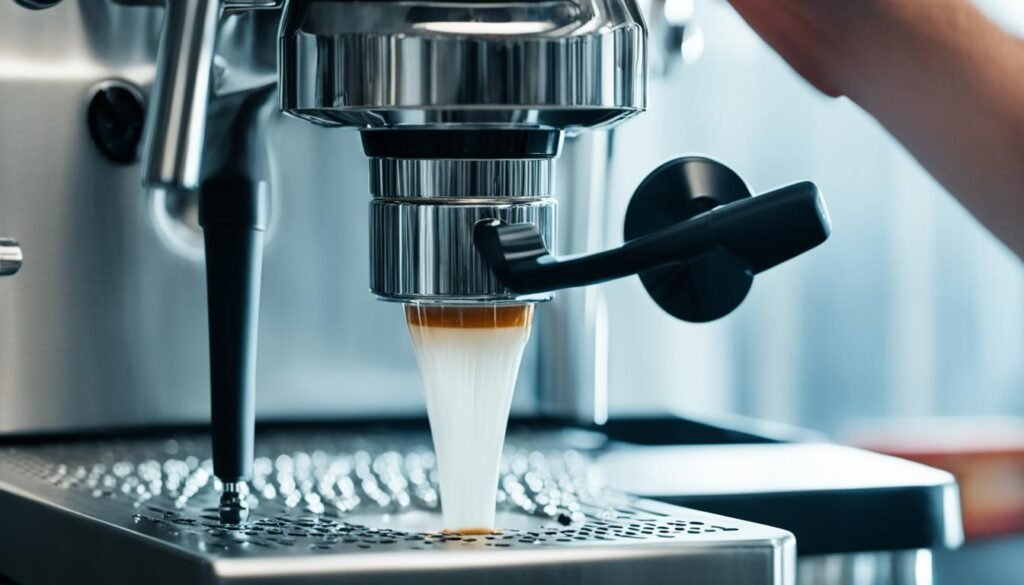
“Purging the group head is one of the most important steps in pulling a great shot of espresso at home. It ensures your machine is at the perfect temperature and helps maintain that stability throughout the extraction.”
Espresso Machine Tips
Elevating your espresso experience goes beyond just mastering the basics. By making a few strategic upgrades to your espresso machine, you can unlock even greater performance and consistent shot quality. Two key areas to focus on are improving your filter baskets and investing in a high-quality tamper.
Upgrade Your Filter Baskets
The stock filter baskets that come with many espresso machines are often adequate, but upgrading to precision-engineered options can make a significant difference. Baskets from brands like VST and IMS feature straight walls and evenly spaced holes, which promote more uniform water flow and extraction. This results in a more balanced, nuanced espresso flavor profile. Espresso Machine Accessories like these upgraded baskets are a worthwhile investment for any serious home barista.
Invest in a Quality Tamper
Consistent tamping pressure is crucial for even extraction and a well-distributed coffee puck. Choosing the Right Tamper can have a noticeable impact on your shots. Look for a tamper that is properly sized for your portafilter basket and has a comfortable, ergonomic handle. Some tampers even feature calibrated pressure gauges to ensure you’re applying the optimal 15-30 lbs of force. Improving Espresso Baskets and tamping technique go hand-in-hand for consistently excellent espresso.
By upgrading your filter baskets and tamper, you’ll be well on your way to taking your espresso game to new heights. These simple equipment upgrades can make a significant difference in the quality and consistency of your shots.
Temperature Surfing for Better Extraction
Mastering the art of Espresso Temperature Surfing can be a game-changer for home baristas seeking to Improve Extraction with Temperature Control and Regulating Brew Temperature on Home Machines. On many semi-automatic espresso machines, the water temperature can fluctuate during the brewing process, making it challenging to achieve consistently optimal extractions.
The technique of “temperature surfing” involves manually purging water from the group head to trigger a new heating cycle. This allows you to pull shots at a more consistent, ideal temperature – typically between 198°F and 202°F. By regulating the brew temperature, you can significantly enhance the quality and consistency of your espresso extractions, especially on machines without advanced PID temperature control.
While it may take some practice, temperature surfing is a valuable skill for home baristas to develop. By learning to manipulate variables like flush time and recovery time, you can explore the upper and lower ends of your machine’s “comfort zone” and find the sweet spot for optimal extraction. With experience, you’ll gain the ability to visually cue in on factors like the water cascade to gauge the temperature and make the necessary adjustments.
Accessories like thermocouple adapters can also aid in monitoring and maintaining consistent brew temperatures. By mastering Espresso Temperature Surfing, you’ll unlock the full potential of your home espresso machine and consistently brew exceptional shots with Improving Extraction with Temperature Control.

“Temperature surfing is a game-changer for home baristas seeking to optimize their espresso extractions.”
Mastering Grind Size and Dose
Achieving consistent espresso extraction is a delicate balance between adjusting the grind size and precisely measuring the coffee dose. The combination of these two variables is critical for dialing in your espresso recipe and unlocking the full potential of your coffee.
Adjusting the grind setting on your coffee grinder is a crucial step in the espresso brewing process. A finer grind will result in a slower extraction, producing a fuller-bodied, more concentrated shot. Conversely, a coarser grind will lead to a faster extraction, resulting in a thinner, more acidic espresso. Making small, incremental changes to your grind size is essential for Adjusting Espresso Grind Size and finding the perfect setting for your taste preferences.
In tandem with grind size, Proper Espresso Dosing Techniques play a vital role in Achieving Consistent Espresso Extraction. Carefully measuring the coffee dose, typically around 18 grams for a double shot, ensures a balanced extraction and consistent flavor profile. Using a precise coffee scale to weigh your dose is highly recommended, as small variations can significantly impact the final result.
“Consistency in both grind size and dose is the key to dialing in exceptional espresso. Mastering these variables takes time and practice, but the rewards are well worth the effort.”
By paying close attention to your grind setting and dose, you can fine-tune the flow rate and balance of your espresso, unlocking a world of flavors and textures. Experiment with small, incremental changes and carefully evaluate the results to hone your skills as an espresso aficionado.
| Parameter | Recommended Range |
|---|---|
| Dose | 18 grams |
| Grind Size | Fine, similar to table salt |
| Extraction Time | 25-30 seconds |
| Yield | 36 grams |
Remember, the journey to mastering espresso is an ongoing one, filled with experimentation and discovery. By honing your skills in adjusting grind size and dose, you’ll be well on your way to Achieving Consistent Espresso Extraction and crafting the perfect shot every time.
Conclusion
Mastering the art of home espresso brewing takes time and practice, but by implementing these expert tips for improving espresso quality at home, you’ll be well on your way to brewing barista-quality drinks in your own kitchen. From selecting the right coffee and properly maintaining your machine to fine-tuning your technique, these comprehensive guidelines will help you unlock the full potential of your espresso setup and elevate your home coffee experience.
The journey to becoming a skilled home barista may seem daunting, but with patience and dedication, you can master the complexities of espresso preparation. By understanding the importance of factors like grind consistency, water temperature, and extraction timing, you’ll be able to consistently produce exceptional shots that capture the full depth of flavor in your freshly roasted beans. Remember, the process of mastering espresso is an ongoing journey, so embrace the challenge and enjoy the process of refining your skills.
Whether you’re a beginner or an experienced home brewer, these comprehensive espresso brewing tips will help you take your coffee game to new heights. So, roll up your sleeves, experiment with different variables, and start crafting café-quality espresso in the comfort of your own kitchen. Cheers to your journey towards becoming a true home espresso expert!
